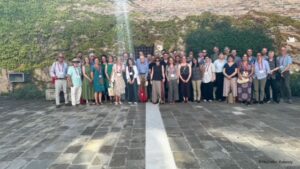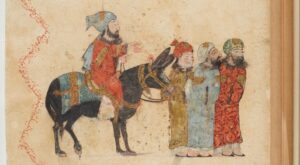The sixteenth Conference of the School of Abbasid Studies (SAS) took place in Venice from July 9th to 13th. I (Noëmie Lucas) was among the participants. I presented my research on fiscal-related narratives with a focus on the case study of ʿUmar b. Mihrān.
The SAS brings together scholars working on various aspects of the Abbasid period, including literature, history, fiqh, and philosophy. The organisation is currently led by five directors: Monique Bernards, Hugh Kennedy, John Nawas, Shawkat Toorawa, and Maaike van Berkel. The conference, hosted biennially, rotates among universities affiliated with its directors or a host institution. This year’s conference was hosted by Antonella Ghersetti at Ca’ Foscari University, with funding from the University of Milano, thanks to Letizia Osti. The invitation-only event typically spans three to four days and features up to twenty-six pre-circulated papers that are publicly discussed. Besides conferences, SAS also publishes The Journal of Abbasid Studies.

Credit Hayrettin Yusecoy
Among the diverse panels, one focused on the East, featuring papers from the Invisible East Team. Arezou Azad presented on the economic life in eastern Abbasid Khurasan from documentary evidence, while Thomas Benfey discussed new sources for early Samanid history with Arabic bifolios from Afghanistan. Additionally, two papers examined Egypt’s history and historiography. On the first day, Matthew Gordon (Miami University) explored representations of elite early Abbasid-era households, specifically al-Balawī’s depiction of the Tulunid household. Later, Jelle Bruning (Leiden University) presented a text from Ibn al-Ṣabbāgh on the merits (faḍāʾil) of Alexandria, dating back to the tenth century.

Fiscal admnistration’s panel – Credit Nassima Neggaz
I presented my research in the frame of the ‘Fiscal Administration’ panel, chaired by Prof. Stefan Heidemann (Hamburg University). My talk, “ʿUmar b. Mihrān: A Man on a Mule and His Slave Boy, or the Story of an Efficient Abbasid Financial Administrator in Egypt,” highlighted a peculiar episode from 176/792 during Hārūn al-Rashīd’s reign when the Barmakids held significant influence. The narratives about ʿUmar b. Mihrān are detailed in al-Ṭabarī’s Taʾrīkh and al-Jahshyārī’s Kitāb al-Wuzarāʾ wa-l-Kuttāb. According to these sources, ʿUmar was dispatched to Egypt to right the wrongdoings of the governor Mūsā b. ʿĪsā. The narratives underscore ʿUmar’s adept handling of fiscal administration, concluding with an intriguing point: “And it is said that he contracted the whole of Egypt without a single dirham being in arrears. And no one before him had accomplished that.” (Kitāb al-Wuzarāʾ wa-l-Kuttāb) / “It is not known that anyone else ever succeeded in collecting by the end of the fiscal year the whole of the taxation of Egypt due.” (al-Ṭabarī, Taʾrīkh)

Ḥarīrī, A. & Wāsiṭī, Y. I. M. (1236) The Assemblies of al-Hariri. Image 159 Retrieved from the Library of Congress, https://www.loc.gov/item/2021667393/.
Interestingly, ʿUmar b. Mihrān is not mentioned in al-Kindī’s Kitāb al-Wulāt, a primary Egyptian source for governor history, as having held any official position in Egypt. However, a papyrus document (CPR XXI 2) might reference him.
In my presentation, I emphasized that both narratives depict ʿUmar b. Mihrān as an efficient and loyal Abbasid official, especially within the context of the Barmakid era. I proposed hypotheses for the discrepancies between sources, suggesting they stem from different perspectives on Abbasid rule and administration. Finally, I analyzed fiscal narratives as rhetorical tools that benefited the state while disadvantaging taxpayers. These themes will be further explored in a forthcoming research article in the Journal of Abbasid Studies. Stay tuned!
Banner picture: View from Ca’ Foscari University on the Grand Canal (Credit Noëmie Lucas)




Leave a Reply